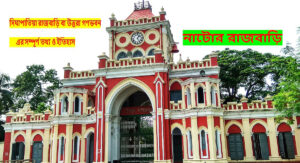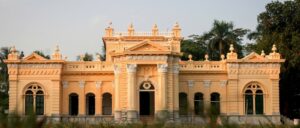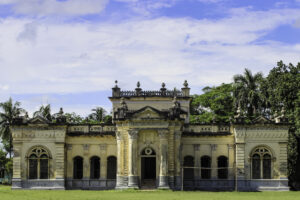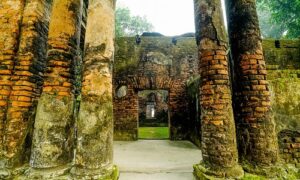Complete information and history of Dighapatia Rajbari or Uttara Ganabhavan
Natore Rajbari is a district of Rajshahi Division of Bangladesh. The full name of the district is “Natore Rajshahi District”. The city of Natore serves as the administrative center of the district. Natore district has a total area of about 3847 sq km and a population of about 38,60,000 (as of 2021 data).

The Nato dynasty originated in the early eighteenth century. In 1706, the zamindars of Pargana Bangachi, Ganesh Roy, and Bhavani Charan Chowdhury, were dismissed for failing to pay the revenue. Dewan Raghunandan settled the zamindari in the name of his brother Ram Ziva. Thus the Nato dynasty fell. Raja Ram Jiban Chowdhury was established as the first king of the Natore dynasty in 1706, later in 1710. He died in 1734. In 1730, Ramakanta, the adopted son of King Rama, was married to Queen Bhavani. Ramakanta became the king of Natore after the death of King Rama. After the death of Raja Ramkant in 1748, Nawab Ali Bardi Khan entrusted the management of the zamindari to Rani Bhawani. During the reign of Rani Bhavani, her zamindari extended to present-day Rajshahi, Pabna, Bogra, Kushtia, Jessore, Rangpur, Murshidabad, Birbhum, Malda districts of West Bengal.
।
Natore district is geographically bounded on the north by the Malda district of the state of West Bengal, India. Natore district is bordered by Naogaon and Chapainawabganj districts on the west. Earlier Natore District was bordered by Rajshahi District, but in 2017 Natore District became a new district as a result of one of the administrative changes in the state of West Bengal, separated from Rajshahi District.

One of the most important rivers in Natore district is the Padma River, which flows along the border between the western and northern parts of the district. Other important rivers of the district are the Atrai River, Chikna River, Barha River,, and Tejal River.
History of Rajbari
King Dayaram Raya, the founder of the Dighapatia dynasty, was the life dewan of King Rama of Natore Raj. Dayaram Roy (1680-1760), the founder of the Dighapatia dynasty, built the main part of the Dighapatia Palace and some adjacent buildings on about 43 acres of land in 1734. On June 10, 1897, during the reign of King Pramdanath Ray, the sixth king of the dynasty, a three-day session of the Bengali Provincial Congress was organized at the Dompara grounds in Natore. Many distinguished persons including the universal poet Rabindranath Tagore attended the session as invited guests. However, on the last day of June 12, 1897, when the royal palace was damaged by a terrible earthquake lasting about 18 minutes, King Pramodnath Roy rebuilt the entire palace complex. Raja Pramodnath Roy built a total of 12 buildings, small and big, including the main building with special craftsmanship inside the palace surrounded by boundary walls. He rebuilt this palace on 41 and a half acres of land with the help of foreign experts, engineers painters, and native masons for 11 years from 1897 to 1908. He made this building a rare royal building with a blend of Mughal and Oriental styles.
Naming:

After partition in 1947, Dighapatiya Raja left the country and went to India. After the passing of the Zamindari Acquisition and Tenancy Act in 1950, several problems arose in the maintenance of the royal palace at Dighapati. To solve the problem, this residence of the Maharajas of Dighapati was inaugurated on 24 July 1967 by the then Governor of East Pakistan, Monayem Khan as the Governor’s Residence. Later, when Bangladesh became independent, on 9 February 1972, Bangabandhu Sheikh Mujibur Rahman changed its name to Uttara Ganobhaban through a ceremony. He convened a cabinet meeting on February 9, 1972, inside the main palace of this building. Since then the building has had the true status of ‘Uttara Ganabhaban’.
At the rear of the palace is a lovely garden with a fountain. In one corner of the garden, there is a statue of a woman made of marble. However, after 1947, no one lived in this building. At present it is open to visitors subject to the permission of the District Administrator of Natore on special arrangements.
Construction of palace

Raghunandan, Ram Jeevan, and the Pandits chose the then Vatjhara Bill to set up the capital of the vast Zamindari in their native land. The bill of Vatjhara was the property of Puthiya king Darpanarayan. For this reason, Raghunandan and Ramjeevan applied to Raja Darpanarayan for Pattani as a ryati. King Darpanarayan gave the land of Brahmotto to the new king. Ramjivan leveled Dighi, Pond, and Chowki in Bill and established Rajbari. Natyapur named the area. Nato’s palace was built in 1706-1710. [7] Raghunandan lived in Baranagar (Murshidabad).
Upazilas of Natore district are:
1. Headquarters of NATO
2. West of Nato
3. NATO’s answer
4. Baraigram
5. Gurdaspur
6. Bagatipara
7. Singra
8. Lalpur
Rajbari is an upazila in Natore district, which is located in the northern part of Natore district. This upazila also houses the town of Natore, which is the administrative center of the upazila.
Description of Rajbari

The total area of Rajbari is 120 acres. There are 8 small and big buildings. There are 2 deep ponds and 5 small ponds. The palace is surrounded by a two-tiered guardhouse. The entire area is divided into 2 parts – the small side and the big side. The notable temples of Rajbari are Shyamsundar Temple, Anandamoyi Kalibari Temple, and Tarakeswar Shiva Temple.
